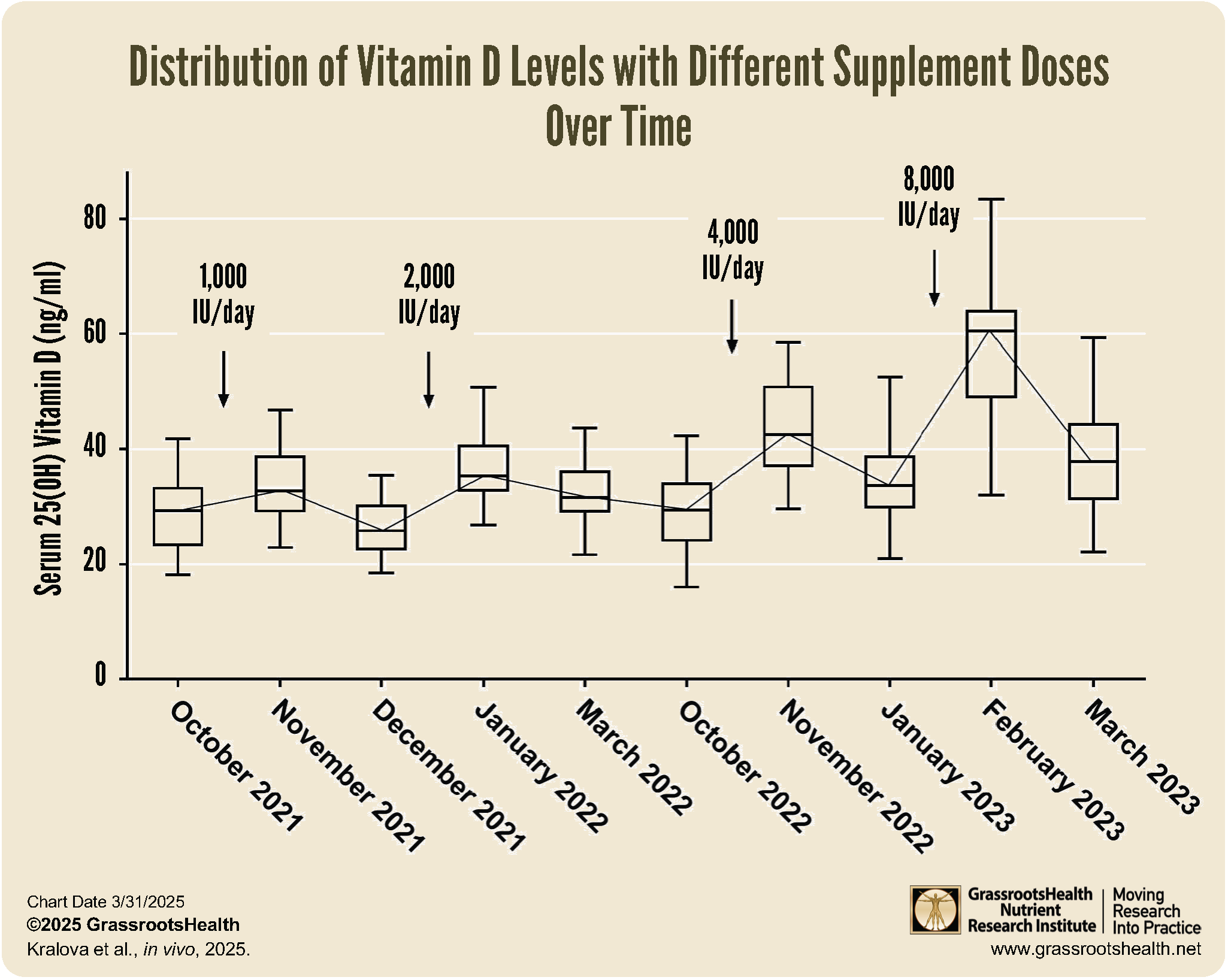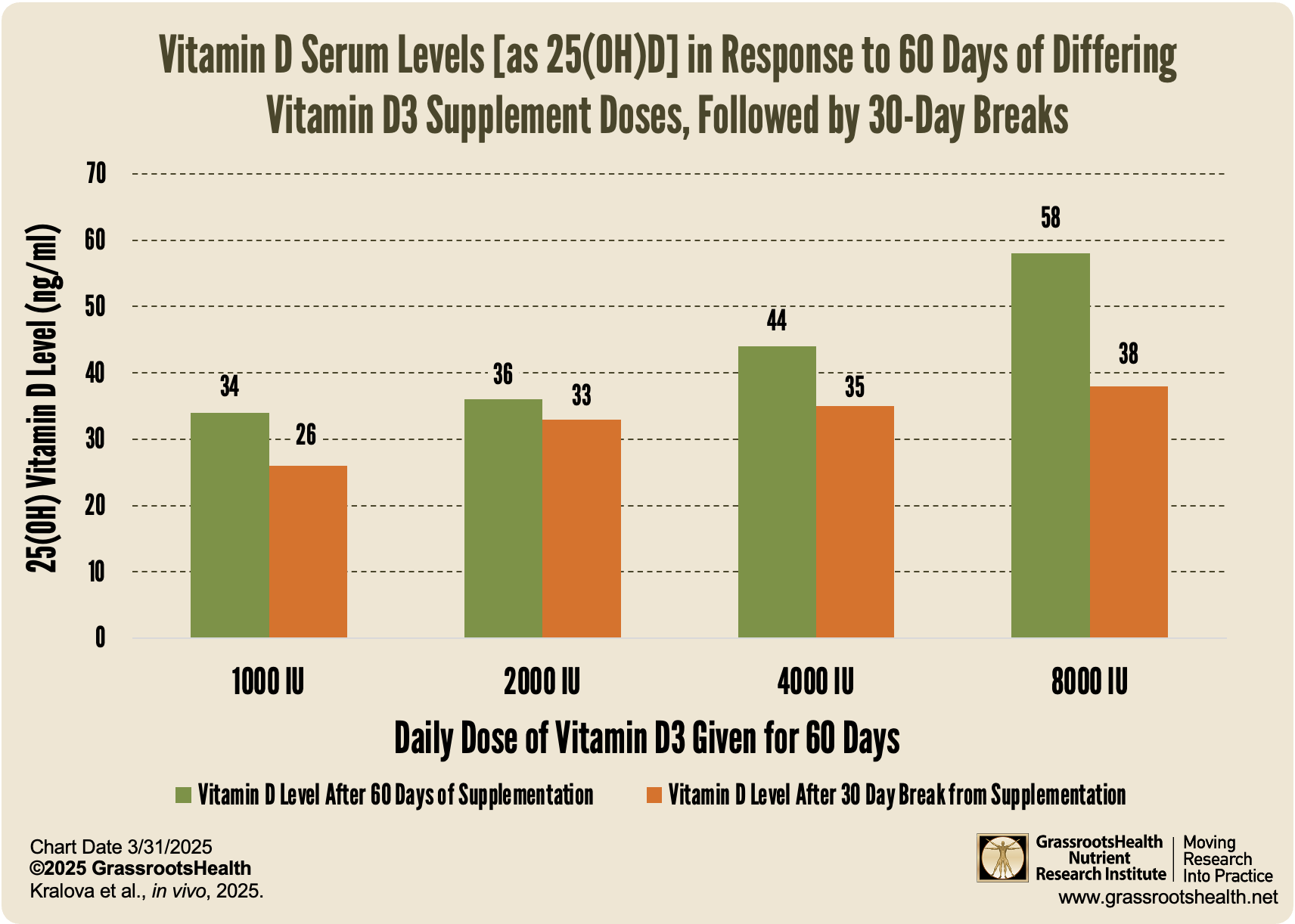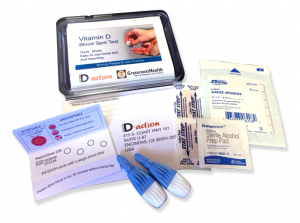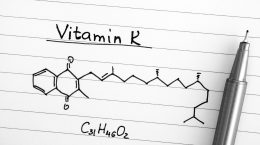Published on March 31, 2025
How starting and stopping different amounts of supplemental vitamin D affects vitamin D levels
Key Points
- A newly published study followed 35 healthy young adults to see how varying doses of supplemental vitamin D would affect vitamin D serum levels after taking them for 60 days, followed by a 30-day break; vitamin D levels were measured before and after each phase
- Taking 8000 IU of vitamin D for 60 days produced the highest vitamin D levels along with the greatest variability in dose response; stopping after this dose amount was followed by the largest drop in serum levels compared to the other supplement amounts
- Even on the same dose, vitamin D levels varied widely, reinforcing the importance of testing and personalized dosing
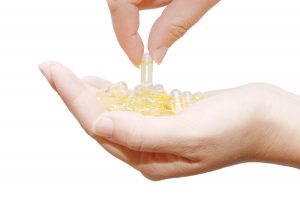 A recently published paper by Kralova et al. (2025) titled Comparison of Vitamin D3 Supplementation Doses of 1,000, 2,000, 4,000 and 8,000 IU in Young Healthy Individuals looked at the rise and fall of 25(OH) vitamin D levels in response to different amounts of supplemental vitamin D, as well as how those changes in serum level varied between individuals.
A recently published paper by Kralova et al. (2025) titled Comparison of Vitamin D3 Supplementation Doses of 1,000, 2,000, 4,000 and 8,000 IU in Young Healthy Individuals looked at the rise and fall of 25(OH) vitamin D levels in response to different amounts of supplemental vitamin D, as well as how those changes in serum level varied between individuals.
The pilot study included 35 healthy young adults (aged 21–26) who were followed over two winter seasons, when natural sun-driven vitamin D production is basically at zero (October to April). Participants took gradually increasing doses of supplemental vitamin D3 (cholecalciferol):
- 1,000 IU/day
- 2,000 IU/day
- 4,000 IU/day
- 8,000 IU/day
Each dose was taken for 60 days, followed by a 30-day break. Vitamin D levels were measured before and after each phase.
How Did Vitamin D Levels Respond to the Differing Doses?
The following outlines the changes seen at each dose:
1,000 IU/day
- Before starting: Average level = 29.1 ng/ml (72.68 nmol/L)
- After 60 days of supplementation: Increased to 33.6 ng/ml (83.87 nmol/L)
- After 30-day break: Dropped to 26.2 ng/ml (65.49 nmol/L)
- Note: Many dropped below 30 ng/ml (75 nmol/L) again after stopping
2,000 IU/day
- After 60 days of supplementation: Vitamin D level rose to 36.2 ng/ml (90.29 nmol/L)
- After 30-day break: Fell slightly to 32.5 ng/ml (81.35 nmol/L)
- Note: Most individuals stayed within or above 30 ng/ml, even after stopping.
4,000 IU/day
- After 60 days of supplementation: Levels rose to 43.9 ng/ml (109.7 nmol/L)
- After 30-day break: Levels decreased to 34.8 ng/ml (87.00 nmol/L)
- Note: Greater gains but also more significant declines after stopping.
8,000 IU/day
- After 60 days of supplementation: Levels rose to 57.6 ng/ml (144.10 nmol/L)
- After 30-day break: Levels fell to 38.0 ng/ml (94.99 nmol/L)
- Note: Highest variability and drop; some individuals exceeded 80 ng/ml (200 nmol/L).
How Did Responses Vary Between Individuals?
In terms of individual variation across all doses, the following observations were made:
- Some participants started as low as 16 ng/ml (40.14 nmol/L) and reached over 81 ng/ml (202.6 nmol/L) on high doses.
- Others had more modest changes, showing how genetics, metabolism, and absorption rates affect individual response.
- Even on the same dose, vitamin D levels varied widely, reinforcing the importance of testing and personalized dosing.
Key Takeaways from the Study
- 2,000 IU/day was enough for most to stay within the range of 30–40 ng/ml, or 75–100 nmol/L through winter.
- 4,000 IU/day was more effective at achieving and maintaining levels above 40 ng/ml (100 nmol/L), which is the minimum level recommended by the GrassrootsHealth panel of scientists and experts.
- 8,000 IU/day resulted in larger spikes and drops, suggesting it’s effective but may need additional monitoring for some individuals wanting to keep their levels in the more moderate range.
- Stopping supplementation leads to rapid decreases in vitamin D levels — so consistency is key
In conclusion, this study demonstrated that while 1,000 IU/day provided a modest increase in vitamin D levels, 2,000–4,000 IU/day gave more stable and lasting results. Most importantly, everyone responded differently to the supplementation amount, making testing vitamin D levels an essential step in determining an effective dose.
How Are Your Levels of Vitamin D and Other Important Nutrients?
Check your vitamin D, omega-3s, magnesium, and other important markers today as part of the vitamin D*action project!
Measure your:
- Vitamin D
- Magnesium PLUS Elements (including zinc, copper, selenium, mercury, cadmium and lead)
- Omega-3 Fatty Acids
- hsCRP (for Inflammation)
- HbA1c (for Blood Sugar)
- and more
Did you know that each of the above can be measured at home using a simple blood spot test? As part of our ongoing research project, you can order your home blood spot test kit to get your levels, followed by education and steps to take to help you reach your optimal target levels. Start by enrolling and ordering your kit to measure each of the above important markers, and make sure you are getting enough of each to support better health and wellbeing!
Start Here to Measure Your Levels


